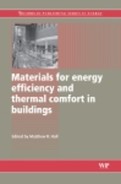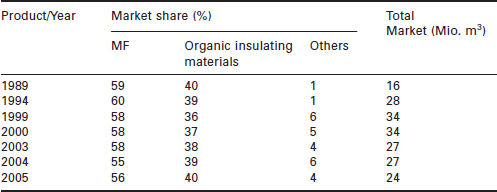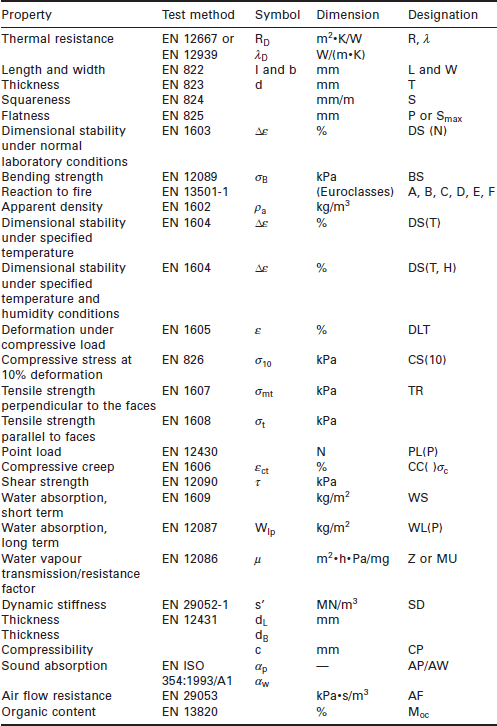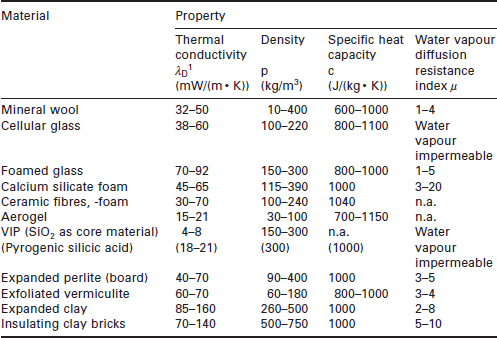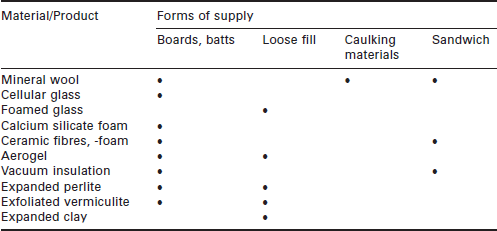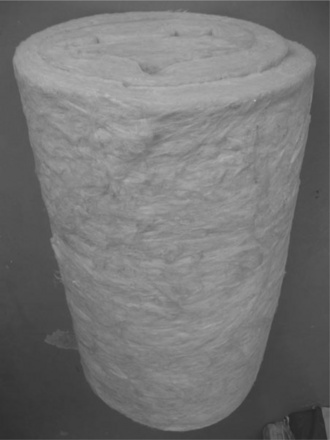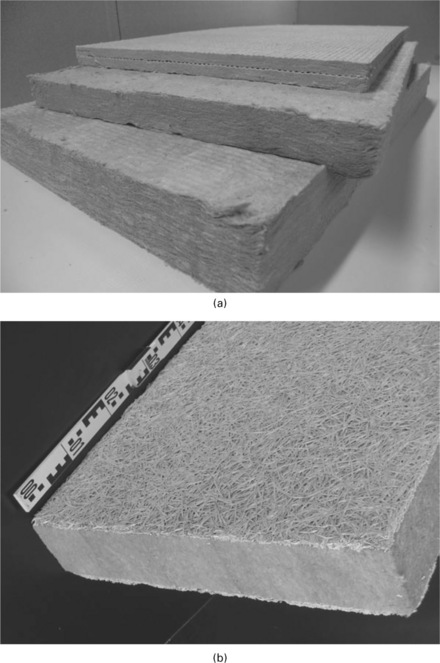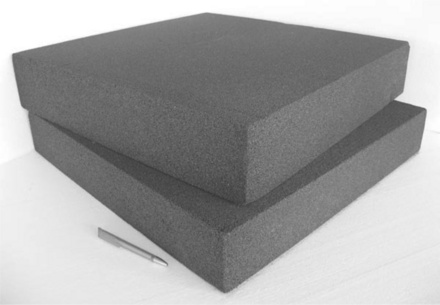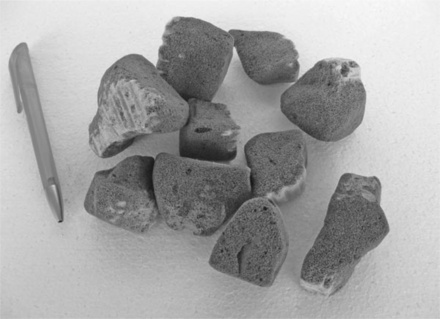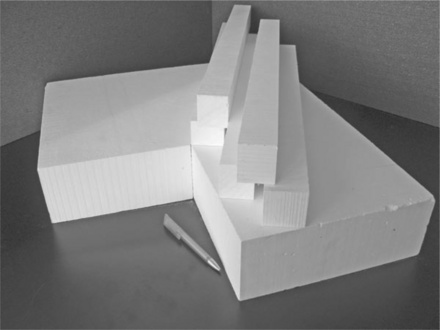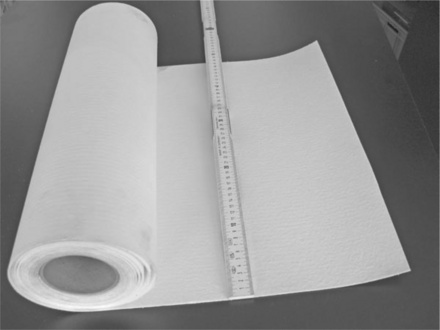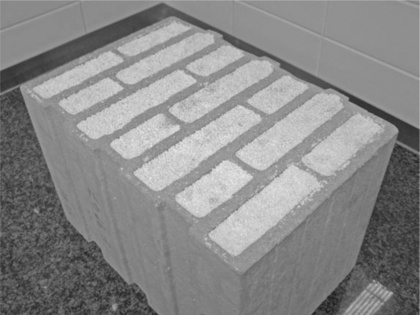Inorganic mineral materials for insulation in buildings *
Abstract:
Insulating products made from natural and/or synthetic mineral raw materials dominate the insulation market in Europe. Owing to their overall cost/performance ratio or their special product properties, mineral wool products for building insulation have gained the largest market share. Products such as mineral wool, cellular glass and expanded perlite are specified by harmonized European standards, while the niche-type products have either a manufacturer-specific European or national technical approval to prove to the consumer the fulfilment of regulatory requirements for the particular application.
8.1 Introduction
Thermal insulation is used to keep buildings cooler in summer and warmer in winter by reducing the flow of heat through the exterior surfaces of the building. The choice of insulation products will be guided by the application for which it is to be used, and the amount of insulation required will depend on the climate of the location, latitude and altitude at which the building is constructed.
Buildings are responsible for 40% of Europe’s energy use and the largest share of energy in buildings is heating [1]. It is thought that up to 50% of buildings in Europe are uninsulated; however, thermal insulation can reduce the heat lost from buildings and therefore save energy and money. European legislation is driving increased installation of insulation through harmonization of building standards up to the levels of the most ambitious Member States.
The European Energy Performance of Buildings Directive (EPBD) [1] was adopted in 2002 and is concerned with promoting energy efficiency in buildings across Europe using cost effective measures, whilst at the same time harmonizing standards across Europe to those of the more ambitious Member States. The EPB Directive centres around four key strands:
• providing a methodology for calculating the energy performance of buildings, taking into account local climatic conditions;
• applying energy performance standards to both new build and existing building stock;
• providing a certification scheme for all buildings;
• regular assessments of any heating and cooling equipment installed.
These components had to be ratified by Member States by 4 January 2006, but most opted to defer this for three years.
Unimpressed by the progress of Member States, the EU launched a public consultation on the recasting of the EPBD in 2008. This recast seeks to, amongst other things, broaden the scope of the EPBD by scrapping the 1000 m2 useful floor space threshold for buildings requiring to meet minimum energy efficiency standards; requiring Member States to apply ‘effective, proportionate and dissuasive’ penalties for non-compliance; and stipulating that Member States must draw up national roadmaps by 2011 for the development of low and zero carbon buildings. This legislation has a significant impact on the levels of insulation required in buildings and is likely to increase demand for insulation products in the future.
As an example, in Germany an ‘Energy Savings Ordinance’ (‘EnEV’) is in effect. Amendments to the EnEV were enacted in the summer of 2008 and gave notice of the following major changes affecting building insulation (reference draft to EnEV 2009):
• tightening of energy requirements on building by an average of 30%
• extension of individual reconditioning obligations for equipment and buildings.
Table 8.1 compares the highest values for the thermal transmission coefficient (Umax) stated in EnEV 2007 and the draft from 2009 for building envelopes on changes to building condition.
Table 8.1
Highest thermal transmission coefficient values in accordance with the German EnEV for renovation of individual building components in existing buildings

The previously applicable version of EnEV specified the limit values to be observed for primary energy consumption of the building as a whole (envelope plus installations) and the specific transmission heat loss for the building (structural elements). Since the U-value (thermal transmission coefficient in W/(m2•K)) is included in the calculation of heat loss, it becomes an important parameter for (un)insulated structural elements. The U-value is a measure for the transmission heat flow through a single or multi-layered material layer which separates two temperature areas (here: ‘external’ and ‘internal’).
The inverse value of the thermal transmission coefficient is the thermal resistance, R (in (m2•K)/W). Both variables are important key figures for the characterisation of insulation effectiveness. The higher the R-value (in other words, the smaller the U-value), the better the material heat insulation properties. Insulation manufacturers will have to regulate their products to meet the (basic) requirements of the EnEV for thermal insulation in buildings.
Thermal insulation materials are subject to heat transmission theories, as are all other building materials. Better heat insulation properties of insulation materials in comparison with other building materials result primarily from the trapped still air (or gases) inside the insulation material. The material of the insulator itself is mostly totally unsuitable or insufficient for thermal insulation on its own. For this reason the main aim in the development of heat insulation materials is to enclose a sufficient quantity of still air or other gases in small pores which are well distributed across the heat insulation material, in addition to using a base material which has as good heat insulation properties as possible. The heat transmission properties or thermal conductivity of insulation material is mainly affected by the following four variables:
• heat transmission of the insulation material framework (cellular framework or fibrous proportion)
• heat transmission of cell gases or gases in the interstices
Good thermal insulation properties are achieved if an insulation material prevents heat transmission due to these four variables as much as possible. Insulation materials are categorized based on their internal structure in order to differentiate the influence of these variables on the insulation material. Since other physical boundary conditions are present in closed-cell insulation materials than in fibrous insulation materials or filled materials, one has to take this into account when judging the performance based on structural parameters of an insulating material.
The thermal conductivity of the insulation material is almost independent both of the internal structure of the insulation material and of the material of the selected solid if the pores are small and well distributed. An increasing solid material proportion, accompanied by an increasing bulk density, results in an increase of the material thermal conductivity; a lower solid material proportion reduces the proportion of thermal conductivity attributable to the material framework for the overall thermal conductivity but does, however, increase the thermal transmission due to radiation due to the increasing proportion of pores [2].
The ‘resulting’ material characteristic value for insulation materials is the thermal conductivity λ (in W/m•K). this is linked to the thermal resistance R by the layer thickness d:
Insulating materials can be separated into organic and inorganic groups based on their raw materials. Furthermore, each group is separated into natural and synthetic materials. Depending on the structure, the results are fibrous materials, foams or granulates. The organic natural raw materials group offers the widest range of products.
The European market is split into these two main product categories according to the chemical and physical structure of the insulation materials: inorganic mineral materials and organic materials (see Table 8.2). For instance, in 1999 building thermal insulation accounted for 65% of the total UK thermal insulation market, compared with 62% in 1995 and this was expected to increase by 8% between 2000 and 2004. the largest share of the market (52%) was represented by wall insulation products, 41% of which consisted of cavity wall insulation.
Table 8.2
Mineral materials employed for the manufacture of insulating materials and products for building applications

Loft insulation had the second largest share, accounting for 25% of the market in 1999. According to a recent study, inorganic fibrous materials will experience a 5% growth in the next decade. It should be noted that these figures are for the UK only and therefore cannot be taken as representative of other eU countries, but indicate their magnitude. the situation in Germany is illustrated in Table 8.3.
8.2 Regulatory requirements
Complementing the EPBD, the European Construction Products Directive (CPD) is aimed at creating a single market for construction products through the use of ‘CE marking’. It outlines key requirements relating to materials intended for construction, which is defined in the Directive as products that are manufactured to form a permanent part of structures.
The materials must meet fundamental requirements including mechanical resistance and stability, safety in case of fire, hygiene, health and the evironment, safety in use, protection against noise and energy economy and heat retention. The Directive mandates that standardization organizations such as CEN develop standards in consultation with industry. A list of these standards can be found on the European Commission’s website. Where harmonized standards are not available, existing national standards may still be used.
Since insulation materials are usually regulated building products, their properties (specifications) are described in technical codes of practice (standards, building authority certification). Now that the building products law based on the European building product guidelines has been passed, harmonized European standards have been produced, or are in the process of being drawn up, for standard market insulation materials.
Their transfer into the national regulations means that they are now given a national EN designation. A different procedure applies to the European technical approvals (ETAs) for insulation materials which have not yet been standardized, but ETAs also have to be accepted nationally.
The harmonized product standards (hEN) are supported by cross-sectional standards such as testing methods, calculations or safeguarding of standard observance. The harmonized specification standards enable insulation material manufacturers to provide a mostly open description of their products using standard features; these are mostly expressed in classes, levels or nominal values (e.g. for thermal conductivity). If the manufacturer declares conformity with the appropriate standard he can give his products the CE conformity marking and place it on the market.
An additional voluntary product certification is based on codes of practice which determine the process by which the conformity verification has been produced in the context of the certification programme. This enables manufacturers to receive a protected marking in accordance with the rules of a certification programme by specific authorized organizations (e.g. quality protection organizations, associations or testing laboratories). Voluntary product certification has a long tradition in many Member States. For insulation materials, such markings are often issued in combination with the Institute supervision previously required by the building authorities and an agreement verification process.
The following information about an insulation material is provided on the label or in the manufacturer’s declaration – the first five being compulsory, others depending on the individual product specification standard:
• thermal conductivity/thermal transmission resistance
• soundproofing characteristics, e.g. dynamic stiffness or length-related air flow restistance
Table 8.4 lists the existing standards, preliminary standards or approvals for the insulating materials and products described in this chapter. As the standards for the factory made products were written according to a ‘model standard’ and published as a ‘package’, the three standards listed in Table 8.4 all have an identical structure.
Table 8.4
European technical specification standardsa and approvalsb for insulating materials based on mineral materials [4], [5], [6]
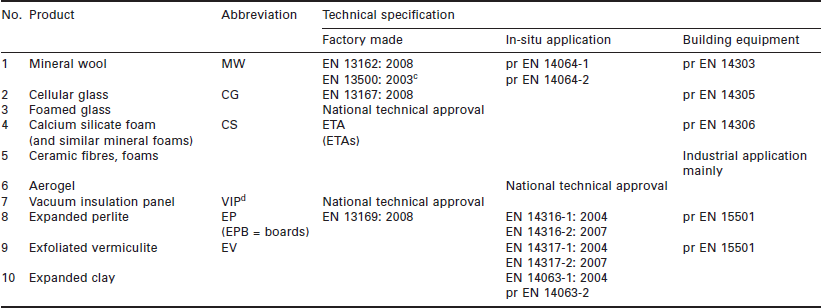
aPublished standards and standards under development are listed by CEN (www.cen.en/CENORM);
bEOTA provides details on technical approvals (www.eota.be);
cEN 13500 specifies MW-products for the external thermal insulation composite system application;
dVIP with pyrogenic silicic acid as core material.
In the ‘heart of the standard’ one will find the requirements, the test methods, the designation code, the rules for the attestation of conformity and the rules for marking and labelling. For insulation products which are produced on-site, the relevant standards – still in the preliminary stage – are written in two parts:
• one part addressing the (basic) raw material
• the second part describing the ‘conversion’ from a loose-fill material into a thermal performance product on site.
Based on properties to be declared for all applications and also – if declared by the manufacturer – for a specific application one can summarize important standardized performance criteria as in Table 8.5.
8.3 Building-related properties
Since differentiation must be made between European and national applications under the harmonized codes of practices in the philosophy anchored in the building products guidelines, the client, planner or architect must take note of the requirements contained in the (national) list of technical building regulations for thermal insulation (sound and fire protection as well, if necessary). In this case the technical regulations of interest for thermal insulation are contained (in Germany) in DIN V 4108: (application-based requirements on insulation materials).
• Part 4:2004-07 Thermal insulation and energy economy in buildings – Part 4: Hygrothermal design values.
• Part 10:2004-09 Thermal insulation and enrgy economy in buildings – application-related requirements for thermal insulation materials – Part 10: Factory made products.
Examples of the most common applications of thermal insulation products in buildings, excluding building equipment are given in Table 8.6. Because of its importance as the most important building-related property, in the European system for handling the thermal conductivity λD (or the thermal resistance RD respectively) of insulation products, one has to follow an elaborate (statistical) scheme, which includes the following details:
Table 8.6
Examples of the most common applications of thermal insulation products in buildings – excluding building equipment [7]
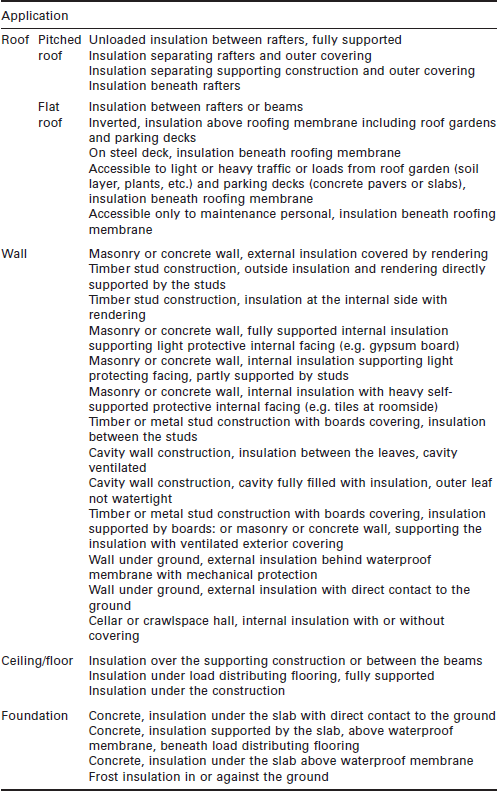
• The declared thermal conductivity λD is determined on the basis of statistically evaluated measurements (λ90/90) – to be organized by the manufacturer. Details are given in the respective product standard (in the normative Annex A); λD is declared in steps of 0.001 W/(m•K).
• Design values for the particular building application are defined nationally – due to different building codes and/or the climate in question.
An overview of the basic building-related properties is given in Table 8.7, some specific properties of interest here in Table 8.8.
Table 8.8
Selected specific properties based on manufacturers’ declarations (where appropriate and given) [8]
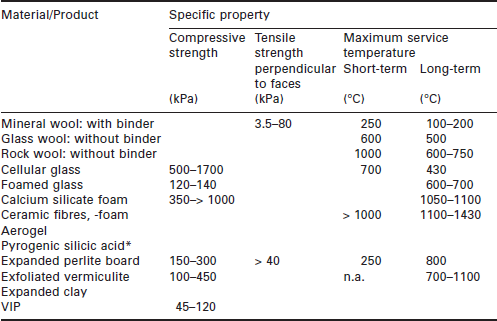
*Core material of vaccum insulation panels(VIP)
Besides the ‘core properties’ which determine the performance of an insulating material, some products have good acoustic or specific fire performance characteristics that the manufacturer wishes to declare – or has to declare for a certain application – already when placed on the market, i.e. the reaction to fire classification. The latter has now been based on the European (classification) standard EN 13501-1 and the following Euroclasses with respect to the combustibility of building materials (reaction to fire) have been agreed upon:


Table 8.9 summarizes those properties.
Table 8.9
Properties related to acoustic and fire performance (manufacturers’ declarations – where given) [8]
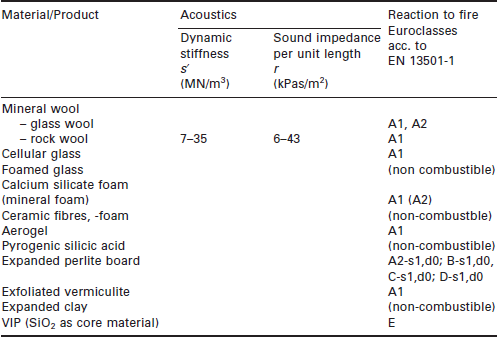
There are six main applications for mineral insulation products in the building sector (general definitions are given here, details with respect to individual products are listed in Table 8.10):
Table 8.10
Application matrix (based on the German DIN 4108–10 and ISO TR 9774) [7], [10]
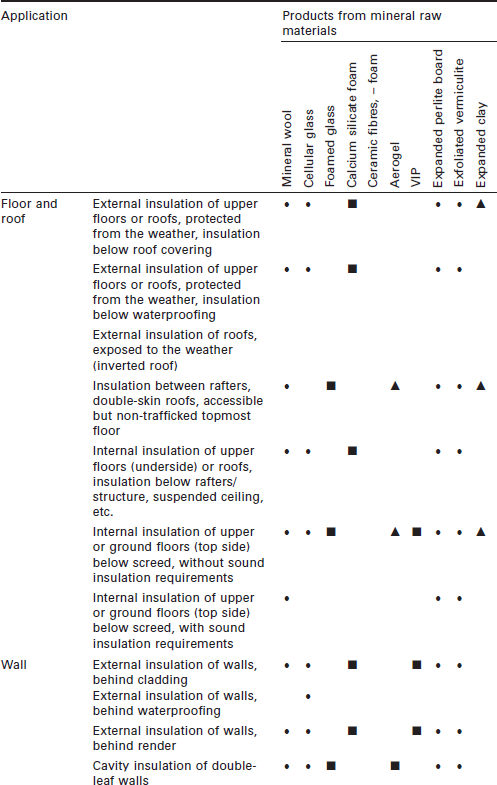
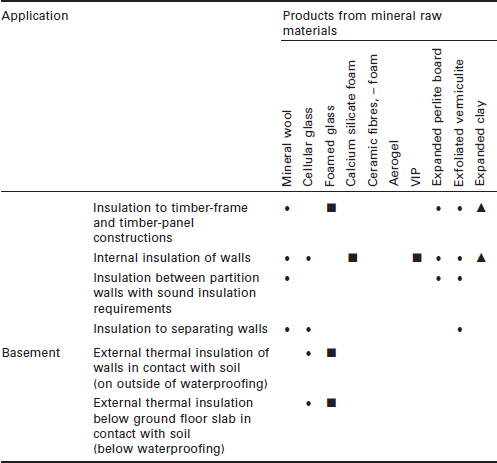
![]() with building authority approval for the product for this application
with building authority approval for the product for this application
1. Cavity wall. A cavity wall is defined as an external wall made of two layers with a small air gap or ‘cavity’ between them. By filling the gap between the two walls with an insulating material, the amount of heat escaping through the walls can be reduced.
2. Solid wall. A solid wall is defined as an external wall without a cavity. Solid walls lose more heat than cavity walls of the same material. However, insulation can be applied to the inside and/or the outside of the wall to reduce heat loss. Insulation boards are typically used for these purposes. Solid walls also cover stone walls which have a random arrangement of cut or more usually irregular broken stone blocks bonded with a cementious mortar.
3. Loft (attic) insulation. Loft insulation is defined as material applied to the floor of the loft, between and over joists. This is most often loose-fill insulation, which is blown onto the loft floor or batts and rolls of insulation are used.
4. Floor insulation. Floor insulation is defined as material that is installed between the beams or joists under a raised floor or, in the case of concrete floors, insulation board installed under floor finishes, such as carpet or under a floating floor.
5. Roof insulation. Here insulation is placed on the underside of the roof instead of on the loft floor. Spray foam (rarely) or insulating boards are most often used for this purpose. Roof insulation between rafters is a major application area for, e.g., mineral wool.
6. Insulation of pipework and ducts as part of building equipment. To preserve the temperature of water and air flowing through pipework and ducts, thermal insulation is used. Insulation of pipework and ducts is defined as lagging or insulation used around pipes or ducts. Products for this purpose are often moulded to the shape of the pipes.
Other types of insulation include prefabricated structural wall and roof panels, e.g. sandwich panels, stressed skin panels, and steel frame systems.
The properties outlined above in the various tables – in short the performance characteristics – have led the products made from mineral materials to be used in certain applications which can best be visualized in a matrix (Table 8.10).
Based on the European technical harmonization, the EU Member States are responsible for developing rules for the specific use of insulating materials in construction works, e.g. in roofs or walls – as outlined in Table 8.10 for Germany as an example.
8.4 Ecological and health aspects
Since industrialization the energy intensity of the production of building materials has increased due to the shift from locally produced raw materials and human energy to high temperature manufacturing processes that consume large amounts of fuel energy and use components and materials that have been transported across the world. This increase in the pre-use energy consumption of materials is accompanied, however, by the advent of insulating materials that can significantly reduce the operational energy use of a building. There is general agreement across the construction industry that installing insulation materials in new and existing buildings is one of the best ways to reduce the environmental impact of buildings. In this respect, any insulation material can be deemed preferable to no insulation. There is a range of insulating materials each with their own benefits in terms of environmental performance.
The life cycle of a thermal insulation product consists of a number of key phases, which are summarized as follows:
• Extraction and processing of raw materials. Mining operations and refining ores for the manufacturing process will result in environmental issues and impacts; these include high energy use, physical disturbance of the landscape and pollution from toxic emissions, which may affect land, water and air. There is scope to use recycled content within many insulation products, which would reduce the impacts at this stage.
• Insulation manufacture. The manufacturing processes for the different categories of insulation vary; however, all have significant environmental impacts, including energy consumption, the use of materials with hazardous properties and the production of hazardous wastes.
• Packaging. The insulation is cut to size and wrapped in packaging to allow transportation. This packaging has environmental implications through its manufacture and, if oil-based polymers are used, it could result in additional non-biodegradable waste if not reused or recycled properly.
• Transport to retail unit. The main environmental impact is energy consumption (fuel use) and associated air quality and emissions by the vehicles. It should be noted that insulation products that require smaller volumes of material and/or are lighter (lower density) to achieve the desired level of thermal resistance might have lower transport emissions. This is due to fewer vehicles being required and/or less energy to transport the material.
• Installation. Transportation from the retail unit to the building where the insulation is to be used has an impact through fuel use and vehicle emissions. The efficiency of the installation also affects the degree of wastage and the efficiency of the insulation (gaps in the insulation can reduce its effectiveness). Also, heavier insulation products may require additional equipment and fixtures to secure them in place compared to lighter (less dense) alternatives.
• Use and maintenance. There is very little in-use impact. However, the maintenance of insulation materials can affect their effectiveness. For example, dampness and compression can reduce the effectiveness of some insulation products as the presence of water or reduced thickness through compaction will increase the amount of heat transferred through the material in comparison to properly dry air-filled insulation. Insulation products with closed cell structures and high compressive strengths are less vulnerable to these factors.
• End-of-life. Reducing further environmental impact will depend on the management and handling of insulation products at the end of their useful life; mismanagement can result in increased impacts on the environment, for example hazardous waste being disposed of to landfill or the emission of toxic particulates into the atmosphere. Disposal options for insulation depend on the type of material used: some will have to be disposed of as hazardous waste.
For each of the phases listed there will be an element of energy input. There will also be emissions to air, land and water and some degree of waste, which will either be suitable for reuse or recycling or have to be sent for disposal. The so-called ‘eco-balance’ takes into consideration all stages of the life cycle, i.e. acquisition, production, use and end-of-life plus transportation for combining the different stages. For a specific use-phase Table 8.11 gives a comparison of the most important ecological parameters.
Table 8.11
Ecological performance based on standardized conditions (U-value = 0.3 W/(m2•K); PE-investment = 0.22 W/(m2•K)) [3]

aCalorific value: Can be gained in a later combustion process.
bPE-Input: Primary energy input covering all energy used to manufacture the product.
cGWP: Global warming potential.
dAP: Acidification potential.
Provided that in the near future data and parameters for all insulation materials are generated on a standardized basis, the end-user can choose their product both on the technical and the ecological performance checklist. However, one should keep in mind that no matter which approved insulating product is chosen, the ‘return-on-energy investment’ is – depending on the climate – usually only one heating period.
Under Mandate 350 of the EU Commission the relevant CEN working group aims to establish a methodology for calculating the use of non-renewable energy (measured in mega joules) for different stages of the product life cycle. The Mandate will lay down the methodology to allow manufacturers to calculate these values and list the use of non-renewable energy and many other environmental/sustainability values in an environmental product declaration (EPD). The EPD will allow contracting authorities to benchmark products based on a comparison of the information included in the EPD.
So far those product characteristics that have been described reflect the more technical performance, i.e. mechanical strength, fire protection, sound insulation and, of course, thermal insulation.
The ‘Essential Requirement 3 (ER 3)’ of the European CPD demands that construction works should not endanger users through any of the following:
• the presence of dangerous particles or gases in the air
• the emission of dangerous radiation
• the pollution or poisoning of the water or soil
• the faulty elimination of wastewater, smoke, solid or liquid wastes
• the presence of damp in parts of the works or on surfaces within the works.
When suitable quality control and professional installation has been applied, it is normally possible to say that there are no health or usage influences through the use of thermal insulation materials. It is, however, necessary to state at this point that there is a possibility of general odour annoyance, formaldehyde gas emissions, (natural) radioactive radiation, dust loading and the danger of pesticide residues. The reusability of an insulation material is mainly dependent on whether it can be dismantled homogeneously and true-to-type. Often this is possible with relatively few problems for filled materials or insulation layers which are only fixed mechanically; the reuse of glued or rendered products is almost impossible. If use of soiled insulation material residues is not possible as an additive mixture or for soil loosening, the material has to be taken to a land-fill or used energetically (as far as is possible and feasible) as an incineration material. Now that national and European politics is becoming more environmentally aware, consideration of the potential harm to health of insulation materials with regard to manufacture, use and disposal is becoming more and more the centre of focus in standardization activities.
8.5 Individual product profiles
As listed in Table 8.2, there are various natural and synthetic (raw) materials employed in the manufacture of mineral insulation products. While most of the products listed play a more or less significant role in terms of market share for thermal building applications, two of the products mentioned, namely slag wool and gypsum foam, are of no importance for the applications addressed in this chapter. Some information about these products can be found in reference [8]. This leaves ten product types that will be profiled in more detail in this section. Table 8.12 lists their usual forms of supply to the marketplace.
8.5.1 Mineral wool
Glass wool (Fig. 8.1) is made from sand, limestone and soda ash with a high proportion of recycled glass, plus other minerals. These are melted, spun into fibres and mixed with organic resins before curing into products. The mineral raw materials are melted at approximately 1400 to 1500 °C. An aqueous binder is sprayed onto the fibres during the spinning process. The fibres cool down fast and stiffen glassily. The binder is then hardened in a tunnel stove at roughly 250 °C through which the products get their structural stability.
Afterwards they can be cut into boards, slabs or batts. The typical composition of glass wool is roughly 70% recycled glass, 0.5 to 7% binder (on a phenolic resin basis) and 0.5% mineral oil to avoid dusting. The other components are derived from the usual glass manufacturing, i.e. quartz and limestone. Recently mineral wool products have been introduced to the market that contain additives (binders) on a renewable organic raw material basis, affecting the optical appearance and improving the ecological balance.
Stone or rock wool (Fig. 8.2a) is based on natural minerals, e.g. volcanic rock, typically basalt, plus recycled post-production waste materials; the components are melted, spun into fibres and then mixed with a binder and an impregnation oil. There is a wide variety of products ranging from loose pelleted materials suitable for cavity wall insulation, to rolls and light boards for loft insulation and dense slabs used for light load bearing application in floors and roofs. Pre-formed pipe insulation and wired matting are used for industrial applications.
Rock or stone wool thus usually contains 30% recycled raw material, i.e. waste glass, 0.5 to 7% binder (phenolic resin polymer) and 0.5% mineral oil, the larger portion composed of the natural raw materials mentioned above.
‘Hybrid products’ combining both raw material basis and technologies are now offered to the market thus combining the high melting point of rock or stone wool with the elasticity of glass wool.
Mineral wool stands out due to its universal material qualities for a wide range of applications. It offers protection from cold and warmth, absorbs sound and offers a good fire protection. In addition, lightweight mineral wool shows good handling properties, is physically quite safe for the health and very resistant to ageing. Furthermore, mineral wool is a highly standardized insulation material. The conformity with standards is supervised by recognized independent institutes (‘notified bodies’) and the products usually carry an (additional) quality mark next to the CE marking, the latter being based on EN 13162. Because mineral wool can be delivered as a non-combustible insulation material, it offers an important contribution to the preventive structural fire protection. Depending on the implementation, it meets most building requirements for fire resistance. Mineral wool products are offered by manufacturers in a large variety of implementation options, e.g. with additional functions like protection against noise. A good insulation in connection with warmth storing mass in the inside area offers very good thermal protection in the summer.
Since mineral wool can be processed with ease from the cellar up to the roof even by DIY enthusiasts in their own home; it has gained wide acceptance in the DIY market. The simple handling of mineral wool is further supported by a versatile choice of ‘system products’ for different problem solutions (Fig. 8.2b). The processing of mineral wool, e.g. at façades (ETICS) should, however, be carried out by professional craftsmen.
As mentioned before, mineral wool products carry a quality mark and comply with certain (national) safety standards. Before the products are marked with a quality mark, the mineral wool manufacturer must undergo quality examinations with respect to the fibre composition and fibre dimensions. These proofs are provided by independent testing institutes. Even after awarding a mark, e.g. in Germany by RAL, the production of the manufacturers is under regular third party control.
Mineral wool can in principle be recycled and utilized again. For example, (production) waste can be supplied again to the mineral wool production process and will be reutilised in new mineral wool. Mineral wool can be disposed of like any other building rubble. The regulations of single individual operators or regional specifications have yet to be taken into account if necessary.
Returning to the health and safety aspect and taking Germany as an example, the so-called ‘chemical ban ordinance’ – more correctly ‘Ordinance for the Change of Chemical Legal Ordinances’ addresses, among other things, the fibre issue. Since June 2000 it states a ban on the circulation, production and use of bio-persistent artificial mineral fibres for heat protection and sound absorption in buildings, and for the technical insulation. At the same time, it includes an exemption regulation for non-bio-persistent, thus biologically soluble fibres which, if in compliance with the three ordinance certificate criteria, are exempted and consequently permitted by the ordinance. The three compliance exoneration certificate criteria are defined clearly; they are derived from the German Hazardous Substances Ordinance and are at the same time the criteria to be obeyed by mineral wool products with a quality mark. Mineral wool products awarded with such a quality mark are not subject to the prohibition of the chemical ban ordinance.
For particular applications, the fibrous structure has been adapted to the specific application needs: in the external wall sector (ETICS), products have been optimized and these new developments provide the market with insulation panels with ‘dual-layer characteristics’: the normal lamellar layers provide the good insulation properties, the high compaction of lamellae on the outer side creates an extremely hard surface layer which makes the application of the reinforcing compound and the rendering easier. Another development, a thermal-bridge-free insulating layer can be applied with fabric rolls for cavity masonry (cavity wall insulation).
8.5.2 Cellular glass
Cellular glass (CG) (Fig. 8.3) is an inorganic thermal insulating material with a closed cell structure. It is mainly made of glass (usually with a high proportion of recycled and waste glass added) plus calcium fluoride, sodium carbonate, iron oxide, manganese oxide, sodium sulfate and sodium nitrate melted at 1400 °C to form glass, then – using carbon as a blowing agent – baked in a high temperature tunnel furnace, annealed in a long tunnel where the temperature is slowly decreased and finally cut into boards or slabs. It well preserves the chemical stability of inorganic glass. As a result, CG has the following features: fairly low density, low thermal conductivity, water and water vapour impermeability, no water absorption, incombustibility, protection from mould, high mechanical strength but easy to cut and able to bear all kinds of chemical erosions except hydrofluoric acid.
Cellular glass, non-toxic in itself, has an excellent durability and a good thermal insulating performance over a wide temperature range (from cryogenic temperature to high temperature). At the same time, it can protect from humidity, fire and erosion. It is praised as ‘permanent thermal insulating material with no need of renewal’, because it is not only safe but also durable in extreme conditions of low and cryogenic temperature, underground, open air, flammability, moisture sensitivity and even chemical erosion. Consequently, it is widely applied in permanent projects as heat and cold insulating material in industry.
For this application the manufacturers supply the industry with specially designed parts, e.g. in shapes of various diameters for pipe insulation. In building application the boards or slabs can be used as insulating material in floors, walls and roofs. Specially cut (‘tapered’) products can be used to construct insulated tapered roof systems. Owing to its brittleness the boards or slabs are usually completely coated in bitumen so they can be laid down evenly. Due to the higher price compared with other standard insulating materials, CG is typically found in applications with high compressive or moisture loads, e.g. roof top car parks or below-ground load-bearing uses. A special load-bearing application is the use of ‘cellular glass bricks’ at the base of single-leaf external walls, at the base of the inner leaf of double-leaf walls on suspended floors over outside air and over the basement. This will help to eliminate thermal bridges.
Depending on the intended use, manufacturers also supply the market with a variety of faced cellular glass boards; the one, or two, facings may be roofing felt, metal foil or paper cardboard or plastic foil. The core of these composites may consist of either one board, a part of a board or a number of boards bounded edge-to-edge in the factory; bitumen may be a suitable adhesive which may be used to bond the joints and the facings. This in turn will, of course, affect the reaction-to-fire rating (Euroclassification).
8.5.3 Foamed glass
Foamed glass (Fig. 8.4) is formed from a reaction between glass and carbon at high temperature resulting in CO2 being trapped in minute bubbles in the glass, giving a cellular structure. It contains no petrochemical binders or preservatives. It is blown with carbon dioxide and has sulphur added. The composition (by volume) of foamed glass is usually: 5% glass, 95% gas (comprising 99% CO2, 0.7% H2S, 0.3% N2). Also waste glass can be recycled into foamed glass yielding a product with excellent mechanical and decent insulation properties. The product is water vapour impermeable and therefore suitable for insulating areas like below-ground structures in contact with soil and water. Because of this inertness foamed glass has an excellent durability and does not rot or grow mould and is resistant to rats or insect attack. This makes this material ideally suited as load-bearing insulation below ground requiring national technical approvals. Depending on the particular application, the foamed glass can be supplied in different grain sizes (from 2 mm up to 50 mm). It is not suitable for acoustic applications or between timbers (too rigid).
8.5.4 Calcium silicate foam and mineral foam
Calcium silicate (CS) foam boards (Fig. 8.5) made with slightly different raw materials are also known as mineral foam or mineral insulating boards. The raw materials for CS are calcium and silicon dioxide plus an aggregate of 3–6% cellulose. These are mixed with water to form a slurry and this produces calcium silicate hydrate. The cellulose content improves flexibility and edge stability. The mixture is poured into moulds and then autoclaved. The result is a fine-pore, open-cell, rigid foam which is subsequently cut into boards and treated with special additives to give it hydrophobic properties. The high service temperature and the good load-bearing property gives the foam its ideal application area in the industrial sector, and with an acceptable price/performance ratio.
The use of calcium silicate foam for the building sector, especially the internal insulation of walls is relatively new. Based on extensive research, it was proven that, due to the high capillary action and hydrothermal material properties, the foam can be used to improve the moisture protection – especially when energetically renovating old buildings where the outside façade is unsuited for insulation measures. Additionally, the high pH of 10 inhibits the growth of fungus.
8.5.5 Ceramic fibres
Standard ceramic fibres (Fig. 8.6) are made from inorganic materials, primarily aluminium oxide (Al2O3) and silicon dioxide (SiO2), leading to very high thermostability. Under normal circumstances standard ceramic fibres can be applied at temperatures up to 1260 °C. By adding small amounts of, e.g., zirconium oxide (ZrO2) the application temperature can be increased to approx. 1600 °C.
Another type of fibre (basis: SiO2–CaO) is a synthetic fibre made from alkaline earth silicates. The fibre is soluble in the human body and consequently completely harmless from a health point of view. Such a fibre can normally be applied at temperatures up to approximately 1100 °C.
Ceramic fibre products are used in areas where good insulating properties at high temperatures are wanted – for packing and for expansion joints. If there is no mechanical wear, ceramic fibres can be used as the only refractory material in contact with high temperature processes, e.g. in kilns for heat treatment of metal, glass, etc.
Ceramic fibre is manufactured with different qualities depending on the production method: the spun and the blown fibre. A spun fibre yields the strongest, but also the most expensive product. In most fields of application the two types of fibre function in the same way, and therefore the spun fibre is the most commonly used type.
Another commonly used type of ceramic fibre is blankets that are manufactured by placing the spun fibre on a conveyor belt. The belt speed and the thickness of the fibre layer determine the two most important quality parameters: density and thickness. The fibre blankets are frequently impregnated, felted, burnt and cut in order to achieve the well-known standard products. The standard fibre blankets are available in the density range 100 to 160 kg/m3 and in thicknesses from 13–50 mm.
Ceramic fibres are also available as massive boards, specially designed modules and wet blankets that are impregnated with a liquid making it possible to form the fibre products into the wanted shape that will remain after heating. Because of their unique (high temperature) properties ceramic fibres are rarely used in conventional thermal insulation applications in buildings.
8.5.6 Aerogel
Aerogel (Fig. 8.7) is an extremely lightweight, highly porous, solid material. Metal oxides or polymers are among the various raw materials possible. However, aerogel is primarily manufactured from silicates (SiO2) which convert to a gel upon addition of a catalyst. This gel is subsequently dried under extreme conditions to a non-brittle consistency. This sol–gel process was developed as long ago as 1930 and over the course of time the mix of raw materials has been varied and improved.
In the meantime, pore sizes range down to 20–40 nm. With a thermal conductivity of 0.017–0.021 W/(m•K), aerogel exhibits excellent thermal insulation properties; it is also good as sound insulation and remains stable in temperatures up to approximately 1200 °C. Aerogels have a density of 60–80 kg/m3. They are resistant to moisture and mould growth and do not discolour even after long exposure to ultraviolet radiation.
Since more than 40% of heat lost from an average building is through the walls, aerogel particles can be a solution for cavity wall insulation, especially in small spaces or historical buildings where a change in the building’s appearance is not acceptable. Aerogel cavity wall insulation is permanent and maintenance free. This in turn can justify the higher price compared with standard insulation materials.
A new commercial development incorporates aerogels into a non-woven fabric or a fibrous blanket; this is especially useful in applications where a thin product is required that can be easily cut, rolled and shaped on the job site, i.e. as a thermal break in places that otherwise conduct heat such as over studs and around windows.
8.5.7 Pyrogenic silicic acid and vacuum insulation panels
Fumed or pyrogenic silicic acid is produced by burning silicon tetrachloride in a hydrogen flame. In conjunction with a stabilizer, this produces a microporous insulating material. In order to minimize the release of radiant heat, opacifiers such as titanium oxide (TiO2) or, for high-temperature applications, zirconium oxide (ZrO2), are added. This mixture, together with reinforcing fibres, is compressed to form boards with densities of up to 300 kg/m3. Depending on the density, this results in rigid or flexible boards with a microporous structure that significantly impedes the migration of gas molecules and hence reduces the thermal conductivity to 0.020 W/m•K. These boards can be used as a core material in the manufacture of vacuum insulation panels (VIPs) (Fig. 8.8a and b).
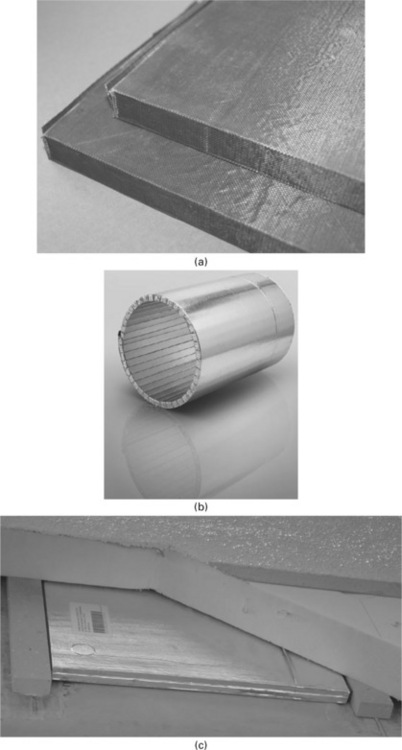
8.8 (a) Vacuum insulation panel VIP, (b) Vacuum insulation cylinder, (c) External wall insulation with VIP Source: va-Q-tec, Würzberg, Germany.
VIPs ‘transform’ the principle of the thermos bottle into a flat panel. The core material like fumed silicic acid is wrapped in a high gas barrier film or foil and then evacuated and sealed. While VIPs have been in use in high performance packaging for some time, only recently have VIPs been especially developed for the (rough) building application.
The core of the panel consists of amorphous silicon dioxide powder and an inorganic opacifier; the panel is sealed under vacuum into a high barrier film or foil which can additionally be covered for protection by a special fleece [9]. During assembly at the construction site care has to be taken in handling and in tightly fitting the panels together avoiding thermal leaks due to the seams of the film covering the panels. Of course, there is no cutting option on the job site.
Due to the low thermal conductivity, the drastically reduced thickness (usually 10–40 mm) allows new solutions in building applications. Figure 8.8(c) shows an exterior wall insulation system utilizing VIPs and a protective layer of polyurethane. The higher costs of the system were more than offset by the gained indoor living space (Munich, 2005).
National approvals have recently been granted, e.g. by the German Institute for Building Technology. In the approval, ageing and edge losses of the panel are taken into account by fixing the design thermal conductivity at 8–11 mW/(m•K) although the initial value might be as low as 4–5 mW/ (m•K). A special manufacturing process allows for the design of cylindrically shaped products that are useful for building equipment and pipe insulation (Fig. 8.8(b)).
8.5.8 Expanded perlite
Perlite is not a trade name but a generic term for naturally occurring siliceous rock. The distinguishing feature which sets perlite apart from other volcanic glasses is that, when heated to a suitable point in its softening range, it expands to four to twenty times its original volume (Fig. 8.9). This expansion is due to the presence of 2–6% water in the crude perlite rock. When quickly heated to above 900 °C, the crude rock expands as the water vaporizes and creates countless small cells which account for the light weight and other exceptional physical properties of expanded perlite. This expansion process also creates one of perlite’s most distinguishing characteristics: its white colour. While the crude rock may range from transparent light gray to glossy black, the colour of expanded perlite ranges from snowy white to grayish white.
Since perlite is a form of natural glass, it is classified as chemically inert and has a pH of approximately 7. Because of perlite’s outstanding insulating characteristics and light weight, it is widely used as a loose-fill insulation in masonry construction. In this application, free-flowing perlite loose-fill masonry insulation is poured into the cavities of part of the structure where it completely fills all cores, crevices, mortar areas and holes. Lightweight brick masonry blocks with factory filled cores are available, too. In addition to providing thermal insulation, perlite enhances fire ratings, reduces noise transmission and it is rot, vermin and termite resistant. Perlite is also ideal for insulating low temperature and cryogenic vessels. When perlite is used as an aggregate in concrete, a lightweight, fire resistant, insulating concrete is produced that is ideal for roof decks and other applications.
Perlite can also be used as an aggregate in Portland cement and gypsum plasters for exterior applications and for the fire protection of beams and columns. Other construction applications include under-floor insulation, chimney linings, paint texturing, gypsum boards, ceiling tiles, and roof insulation boards. The insulation boards (EPBs) (Fig. 8.9b) are usually manufactured in a process which blends the expanded perlite particles with reinforcing fibres, special binders and hydrophobic additives. For the internal insulation of walls and ceilings, a special fibre-free board has been developed, which not only reduces the heat loss but also helps to control the indoor air humidity. Composite boards, e.g. EPB in combination with mineral wool, are also offered to the market.
8.5.9 Exfoliated vermiculite
Vermiculite is the geological name given to a group of hydrated laminar minerals which are aluminium iron magnesium silicates resembling Mica in appearance. Minute layers of water are trapped between the plates, and when the particles are subjected to heat (> 1000 °C) they have the unusual property of exfoliating, or expanding, due to the inter-laminar generation of steam (Fig. 8.10). A typical chemical composition is given in Table 8.13.
In its exfoliated state, vermiculite has the following important qualities: low density, moderate low thermal conductivity, high temperature resistance, high absorbency, high specific surface area and cation exchange property. It is also non-toxic and sterile.
Exfoliated vermiculite will readily hold liquids within the inter-laminar voids of particles. It will also hold a certain amount between the individual particles. Water retained as a percentage of the air dry weight will be approximately 240%. Typical building-related applications are loft insulation and cavity fill.
Exfoliated vermiculite is available as aggregate (EVA), coated (EVC), bitumen-coated (EVB), hydrophobic (EVH) and in a pre-mixed form (EVM).
8.5.10 Expanded clay
Expanded clay pellets (Fig. 8.11), most commonly known under the brand names LECA (acronym of light expanded clay aggregate) or LIAPOR (porous lias clay), also known as Hydroton and under the non-proprietary terms fired clay pebble, grow rocks, expanded clay (pellets) or hydrocorns, are small globes of burnt and expanded clay, used in construction and farming, and especially in hydroponics. After being thoroughly prepared, the raw clay is burnt at a temperature of about 1200 °C in a rotary kiln. During this process the organic components of the clay, which are evenly dispersed, combust. The spheres expand and expanded clay with very fine pores comes into existence. The weight, size and strength can be controlled exactly. The pellets are available in different sizes such as 4–8 mm in diameter. The dry density of lightweight expanded clay aggregates is 300 to 500 kg/m3.
Expanded clay pellets offer decent insulation properties, they are lightweight and heatproof. Due to their low weight and good shear strength the product is used for lightweight fill in civil engineering structures to reduce settlement and reduce pressure on structures. The still preliminary European standard prEN 15732 describes the specifications needed for this application.
Expanded clay is very open to diffusion and can absorb a considerable amount of moisture. It is an incombustible material and is also highly resistant to chemicals. Rodents and insects find no nutrients in expanded clay; however, fungi can grow on it if moisture is constantly present.
When used as a thermal insulation material, expanded clay is mainly used to fill voids and, for example, contributes to improving the sound insulation of suspended floor constructions. Expanded clay is also used as an aggregate in the manufacture of masonry units and precast concrete elements, and in a small grain size for improving the insulation properties of mortar, render and plaster.
8.5.11 Insulating clay bricks (Fig. 8.12)
The brickmaking industry has been offering special masonry units with a thermal conductivity of < 0.1 W/(m•K). Their insulating effect is therefore close to that of some thermal insulating materials and thus should be mentioned in this chapter.
The clay content of the bricks has been reduced by optimizing the arrangement of the hole pattern to such an extent that the load-bearing capacity for normal structural requirements is still sufficient but at the same time the thermal insulating properties are considerably better than before. Additionally, the holes can be filled with an insulating material. Expanded perlite (EP) or special mineral granulate are used as a filling material; at a density of 650 kg/m3 the thermal conductivity can be as low as 0.09 W/ (m•K) for the design value. In order to reduce the mortar’s influence on the thermal conductivity of the wall, these products are constructed exclusively as precision bricks laid in thin-bed mortar.
8.6 Summary
Insulating products made from natural or synthetic mineral raw materials dominate the insulation market in Europe due to their overall cost/performance ratio or their special product properties, mineral wool products for building insulation having gained the largest market share.
The versatility of the raw materials and the different production processes allow for a wide range of combinations of product properties: from commodity type insulation materials to highly specialized materials for niche-type applications in the building and the industrial sector. Very often it is the combination of thermal, fire and acoustic performance that make the materials described in this chapter the ‘product of choice’. For trading in the European market, products like mineral wool, cellular glass and expanded perlite are specified by harmonized CEN standards, while the niche-type products have either a manufacturer-specific European or national technical approval to prove to the consumer the fulfilment of regulatory requirements for the particular application.
8.7 References
2. Gibson, L.J., Ashby, M.F.Cellular Solids: Structure and Properties. Oxford: Pergamon, 1988.
3. Danner, H. Comparison of ecological insulating materials. Munich www.muenchen.de/bauzentrum, 2008.
4. EN 13162. Thermal insulation products for buildings – factory made mineral wool (MW) products – specification, 2008.
5. EN 13167. Thermal insulation products for buildings – factory made cellular glass (CG) products – specification, 2008.
6. EN 13169. Thermal insulation products for buildings – factory made products of expanded perlite (EPB) – specification, 2008.
7. ISO TR 9774. Thermal insulation for building applications – guidelines for selecting properties, 2004.
8. Pfundstein, M., Gellert, R., Spitzner, M.H., Rudolphi, A., Insulating materials. Edition Detail. Institut für internationale Architektur – Dokumentation GmbH & Co. KG, Munich, Germany, 2007. [English version: distributed by Birkhäuser – Publishers for Architecture, Basel, Switzerland (2007)].
9. DIN 4108-4. Thermal insulation and energy economy in buildings – Part 4: Hygrothermal design values, 2004-07.
10. DIN V 4108-10. Thermal insulation and energy economy in buildings – application-related requirements for thermal insulation materials – Part 10: Factory made products, 2004-06.
*This chapter is dedicated to Dr Walter F. Cammerer on the occasion of his 90th birthday.
